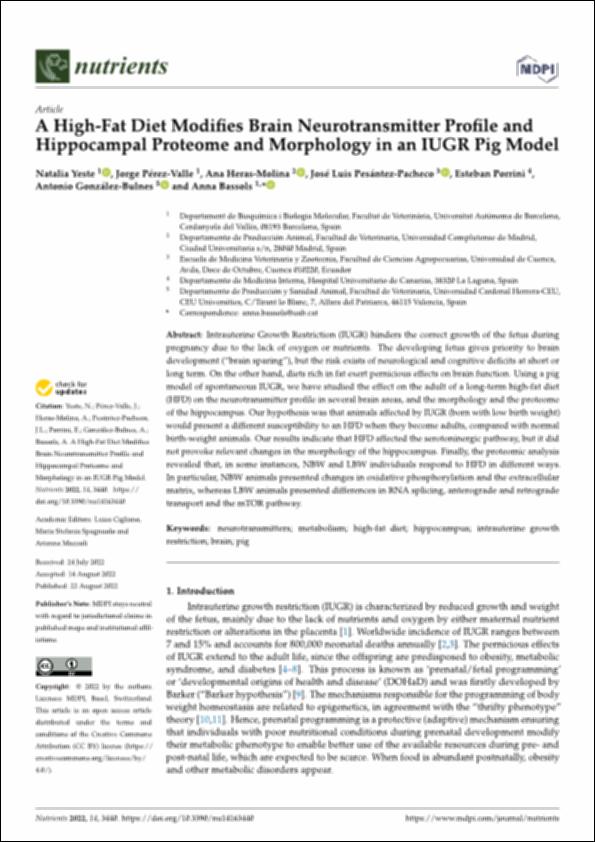Por favor, use este identificador para citar o enlazar este ítem:
http://hdl.handle.net/10637/14280A high-fat diet modifies brain neurotransmitter profile and hippocampal proteome and morphology in an IUGR pig model
| Título : | A high-fat diet modifies brain neurotransmitter profile and hippocampal proteome and morphology in an IUGR pig model |
| Autor : | Yeste Vizcaino, Natalia Pérez Valle, Jorge Heras Molina, Ana Pesántez Pacheco, José Luis Porrini, Esteban González de Bulnes López, Antonio Bassols Teixidó, Anna |
| Materias: | Cerdos - Alimentación.; Aceites y grasas en nutrición.; Lipids in nutrition.; Swine - Neurology.; Neurotransmitters.; Hippocampus (Brain); Neurotransmisores.; Swine - Feeding and feeds.; Cerdos - Neurología.; Hipocampo (Cerebro) |
| Editorial : | MDPI |
| Citación : | Yeste, N., Pérez-Valle, J., Heras-Molina, A., Pesántez-Pacheco, J. L., Porrini, E., González-Bulnes, A., & Bassols, A. (2022). A high-fat diet modifies brain neurotransmitter profile and hippocampal proteome and morphology in an IUGR pig model. Nutrients, vol. 14, i. 16 (22 aug.), art. 3440. DOI: https://doi.org/10.3390/nu14163440 |
| Resumen : | Intrauterine Growth Restriction (IUGR) hinders the correct growth of the fetus during pregnancy due to the lack of oxygen or nutrients. The developing fetus gives priority to brain development (“brain sparing”), but the risk exists of neurological and cognitive deficits at short or long term. On the other hand, diets rich in fat exert pernicious effects on brain function. Using a pig model of spontaneous IUGR, we have studied the effect on the adult of a long-term high-fat diet (HFD) on the neurotransmitter profile in several brain areas, and the morphology and the proteome of the hippocampus. Our hypothesis was that animals affected by IUGR (born with low birth weight) would present a different susceptibility to an HFD when they become adults, compared with normal birth-weight animals. Our results indicate that HFD affected the serotoninergic pathway, but it did not provoke relevant changes in the morphology of the hippocampus. Finally, the proteomic analysis revealed that, in some instances, NBW and LBW individuals respond to HFD in different ways. In particular, NBW animals presented changes in oxidative phosphorylation and the extracellular matrix, whereas LBW animals presented differences in RNA splicing, anterograde and retrograde transport and the mTOR pathway. |
| Descripción : | Este artículo se encuentra disponible en la siguiente URL: https://www.mdpi.com/2072-6643/14/16/3440 Este artículo de investigación pertenece al número especial "The Impact of Nutrition on Brain Metabolism and Disease". |
| URI : | http://hdl.handle.net/10637/14280 |
| Derechos: | http://creativecommons.org/licenses/by/4.0/deed.es |
| ISSN : | 2072-6643 (Electrónico) |
| Idioma: | es |
| Fecha de publicación : | 22-ago-2022 |
| Centro : | Universidad Cardenal Herrera-CEU |
| Aparece en las colecciones: | Dpto. Producción y Sanidad Animal, Salud Pública Veterinaria y Ciencia y Tecnología de los Alimentos |
Los ítems de DSpace están protegidos por copyright, con todos los derechos reservados, a menos que se indique lo contrario.


